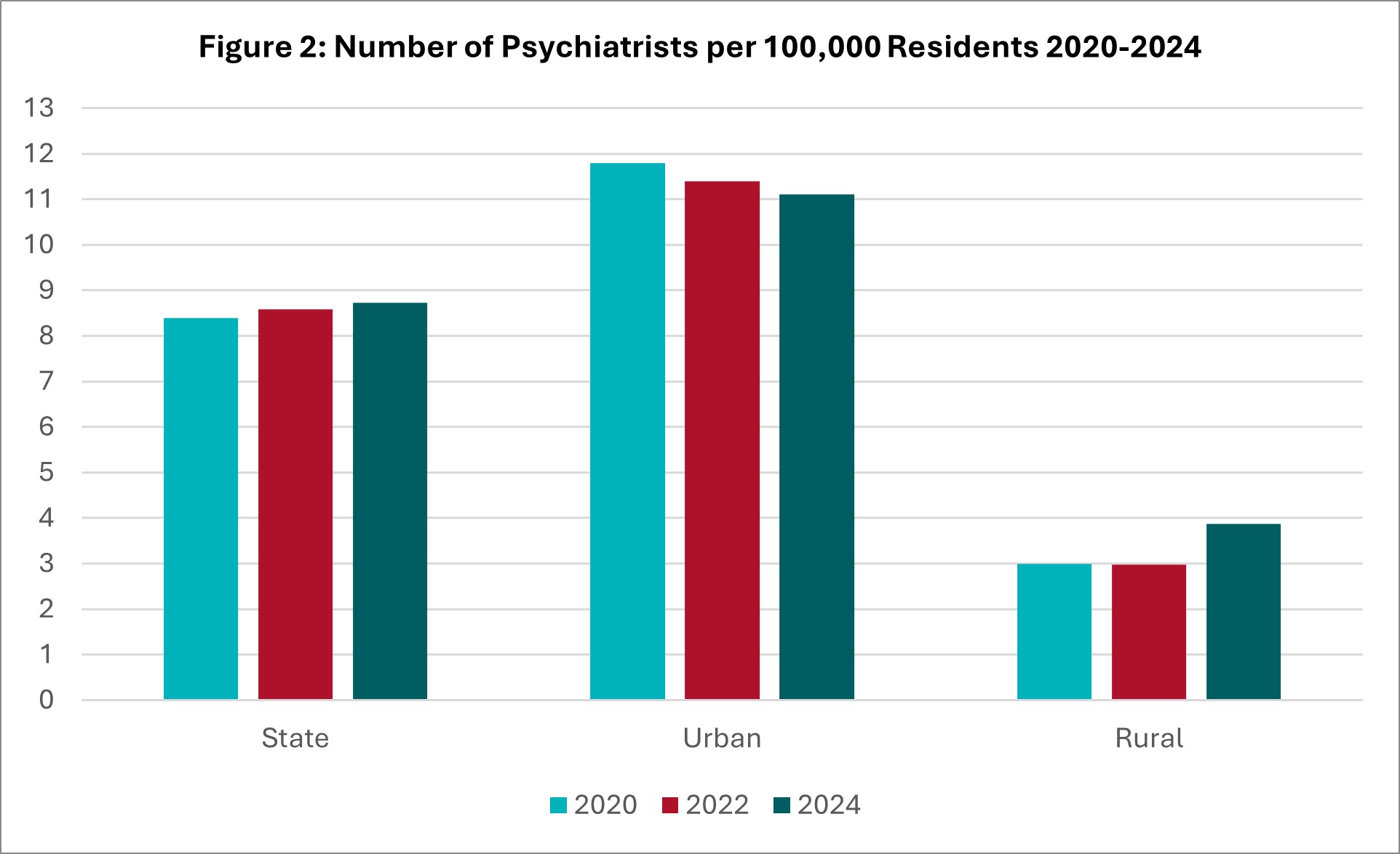The Psychiatry Workforce in Nebraska: 2020 to 2024
Purpose
BHECN utilizes data from the UNMC Health Professions Tracking Service to determine the number and type of licensed behavioral health professionals who practice in Nebraska. This data snapshot includes information about the Psychiatry workforce from 2020 to 2024.
Psychiatrists are licensed physicians who specialize in the diagnosis, treatment and prevention of mental illnesses. Psychiatrists prescribe medications, provide talk therapy and care for patients with complex medical problems. Psychiatrists work in numerous settings, including academic health centers, private practices, hospitals and emergency rooms, primary care clinics, community agencies, courts and prisons, long-term care facilities/assisted living facilities, hospices, industry, government, military settings, schools, universities, and substance use programs.
Key Findings
- The Nebraska psychiatry workforce grew 8% from 2020 to 2024.
- The number of psychiatrists increased in five of the six Nebraska Behavioral Health Regions and in rural areas; however, rural areas remain underserved.
- Growth in the number of psychiatrists in Nebraska is constrained by the long training period and the limited number of training programs and statewide training opportunities.
Regional Trends
The number of licensed psychiatrists practicing in Nebraska increased 8% from 2020 to 2024 (from 162 to 175). The number of psychiatrists increased in all Nebraska Behavioral Health Regions except Region 3 (see Figure 1).[1]

Rural and Urban Distribution of Psychiatrists
The number of psychiatrists in rural areas increased in 2024, but rural areas still have fewer psychiatrists per 100,000 population compared to urban areas (see Figure 2). At just under 4 psychiatrists per 100,000 population, Nebraska rural counties are significantly below the national average of 10.5 psychiatrists per 100,000 population.[2] However, both urban and rural areas fall short of the 26 psychiatrists per 100,000 population estimated in 2001, which is needed to meet the demand for services.[3]

Age of Psychiatrists
Since 2020, the number of psychiatrists at or nearing retirement age has decreased, and the number of psychiatrists aged 36-45 has increased (see Figure 3).

Psychiatry Training Programs
Of all the behavioral health professions, becoming a psychiatrist takes the longest amount of time. The average length of training is 12 years (4 years to complete a bachelor’s degree; 4 years of medical school; and 4 years of psychiatry residency). Additionally, post-residency fellowships of 1-2 years are common. There are two psychiatry residency programs in Nebraska: the Creighton University program and the University of Nebraska Medical Center (UNMC) program. The Creighton program was established in 1987, and the UNMC program was established in 2020. Each program supports up to 5 new residents per year.
Psychiatry training spots in Nebraska are significantly more limited than those in other behavioral health specialties, primarily due to the intensive training required for this field. Furthermore, the residency match process may require students to relocate to another state to complete their training. The National Resident Matching Program® pairs residency program choices of graduating medical students from across the US with those of residency programs seeking trainees. While some Nebraska students may choose to leave for residency, others who initially wanted to stay in Nebraska may match with a program elsewhere. In 2023, only 48% of graduating medical students matched to their first-choice program.[4] In general, Nebraska retains 54% of the residents who train here.[5] However, more psychiatrists remain in the state where they complete their residency than in other specialties (68% vs 59%) [6], meaning that if they train outside of Nebraska, they are more likely to stay there than return to Nebraska.
Although both residency programs are in Omaha (Region 6), BHECN funding supports rotations in rural areas. Creighton University has recently introduced the Psychiatry Rural Track Program, which includes rotations in Kearney during the third and fourth years of training. The UNMC program also offers rural rotations in the second year of training. Residents can also become involved in rural outreach via telehealth.
Conclusions
The psychiatry workforce in Nebraska has grown since 2020, including in rural areas, and nearly all regions experienced an increase in numbers. However, the availability of psychiatrists remains higher in urban areas compared to rural areas, and the number of providers per 100,000 residents is substantially lower than the national average. Growth in the number of psychiatrists in Nebraska is constrained by the long training period and the limited number of statewide training opportunities.
Suggested citation:
Behavioral Health Education Center of Nebraska. (2025). The Psychiatry Workforce in Nebraska: 2020 to 2024. https://www.unmc.edu/bhecn/research-data-policy/2020_2024_psychiatrist_snapshot.html
Footnotes
[1]Nebraska Department of Health and Human Services. (2025). Behavioral Health Resources for Schools: Division of Behavioral Health. https://dhhs.ne.gov/BHSchoolResources/AboutDBH.pdf
[2]World Health Organization. (2025). Psychiatrists Working in the Mental Health Sector (per 100,000). https://www.who.int/data/gho/data/indicators/indicator-details/GHO/psychiatrists-working-in-mental-health-sector-(per-100-000)
[3] Konrad, T. R., Ellis, A. R., Thomas, K. C., Holzer, C. E., & Morrissey, J. P. (2009). County-level estimates of need for mental health professionals in the United States. Psychiatric Services, 60(10), 1307-1314.
[4] AAMC (2023). NRMP Releases the 2023 Main Residency Match Results and Data Report, the Most Trusted Data Resource for the Main Residency Match. https://www.nrmp.org/about/news/2023/05/nrmp-releases-the-2023-main-residency-match-results-and-data-report-the-most-trusted-data-resource-for-the-main-residency-match/
[5]AAMC (2024). Report on Residents. https://www.aamc.org/data-reports/students-residents/data/report-residents/2024/table-c6-physician-retention-state-residency-training-state
[6] AMA. (2025). How training location, specialty affect where doctors go after GME. https://www.ama-assn.org/medical-residents/transition-resident-attending/how-training-location-specialty-affect-where